|
|
 |
|
In this stage, the following activities have been performed:
Radioactive wastes are wastes containing artificial radionuclides. Radioactive waste, is the result of a process such as nuclear fission. International Atomic Energy Agency classification of radioactive waste , |
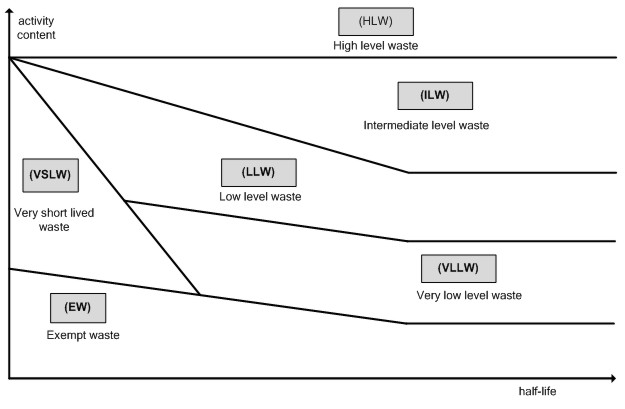 |
|
In this phase of study, next two clases of waste are analized: Very low level waste (VLLW) Substantial amounts of waste arise from the operation and decommissioning of nuclear facilities with levels of activity concentration in the region of or slightly above the levels specified for the clearance of material from regulatory control. Other such waste, containing naturally occurring radionuclides, may originate from the mining or processing of ores and minerals. Low level waste (LLW) Low level waste, are waste containing radionuclides at a higher level than excluded waste, but had a limited level of radioactivity for long time. They require a high level of isolation and storage, for periods up to several hundred years. This class covers a very wide range of radioactive waste, ranging from radioactive waste with an activity content level just above the level for VLLW, i.e. not requiring shielding or particularly robust containment and isolation, to radioactive waste with a level of activity concentration such that shielding and more robust containment and isolation are necessary for periods up to several hundred years.. Detailed classification of low level radioactive waste |
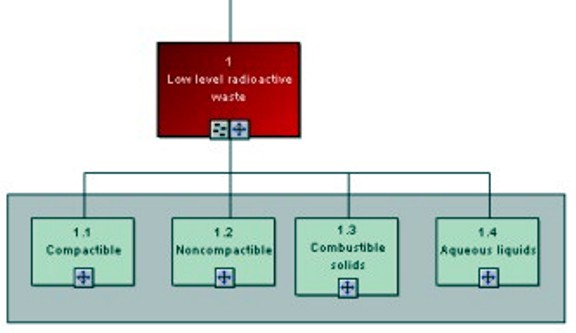 |
|
Low level active waste volume from 4 units of Cernavoda NPP decommissioning |
|
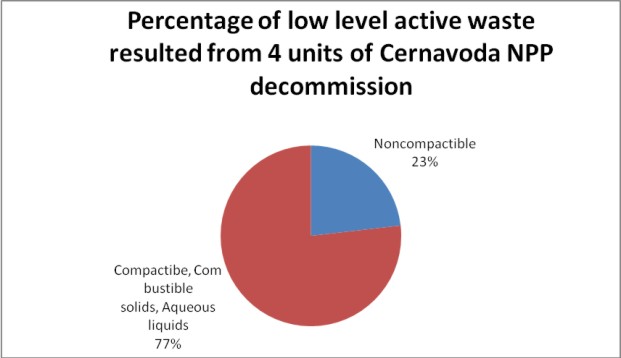 |
|
Low active waste management methodologies have been performed from generation in nuclear power plants decommissioning process (Cernavoda NPP, for instance) to disposal in a near surface repository (in SITON’s studies the Saligny site is proposed) or recovery and recycling of the waste. The presented issues refer to the selection and implementation of the most favorable decommissioning materials disposal strategies, which are mentioned as options, factors and methodologies based upon the international experience in this field and in accordance with IAEA and NEA-OECD recommendations. There have been identified more disposal or recycling/re-using/disposal options as LLW (low level waste), VLLW (very low level waste), radiologically clean waste or simply clean waste; recycling/re-using in nuclear industry, in non-nuclear applications or unconditionally released. All these options have in view the commissioning of near surface repository with multiple engineering barriers according to the best European Union countries practices for low level waste and a repository with trenches for very low level waste. Factors influencing an option to be included in the disposal strategy of a site which is going to be decommissioned have been specified. They cover issues such as the quantity of materials involved and radiological release criteria availability and technical solutions to meet them in a safe and controlled manner. Moreover, the future utilization of the decommissioned site and the option’s economic issues, in this context, are also very important. The successful implementation of the selected strategy shall be based on the quality management system for material characterization, management and economic and safe monitoring to allow the materials resulted from decommissioning to follow the selected path. These processes need support from practical and adequate methodologies, and the paper realized by CITON describes the methodologies either directly, either with reference to the existing experience in industry or worldwide. The paper elaborated by CITON develops methodologies to select the analyzed options, in the framework of the existing criteria constraints of release from the authorization regime of the material. It was considered that Cernavoda NPP will have 4 units in operation for an average time of 40 years until final shut-down. Moreover, it was considered that at Cernavoda NPP measures to minimize the waste volume will be applied, mainly by approval and implementation of some radioactive waste release levels from the authorizing regime in accordance with IAEA and NEA – OECD recommendations. It was proposed the analysis of five options for the STDR (Radioactive Waste Treatment Facility) corresponding to Saligny DFDSMA (Low and Intermediate Waste Repository). STDR is initially proposed for operational radioactive waste treatment and conditioning, but its operation time may extend in order to process the waste resulting from decommissioning of the plant’s units through suitable arrangements. Treatment and conditioning technologies used at STDR will significantly influence, as previously shown, the disposal capacity dimensioning of the DFDSMA Saligny surface repository. The five technologies options proposed by different companies with experience in this field can by applied for both low active waste and mixed and intermediate active waste. In the framework of the study realized by CITON, the concise description of these technologies only emphasized the low active waste. Regarding the generated volume, the operation and decommissioning of nuclear facilities, especially nuclear power plants, represent the most important source of low and intermediate active waste in the world. Decommissioning waste processing and disposal spend a significant amount of money from the total budget allocated to the respective facility, and the sustained effort to reduce these costs represents one of the main objective in the radioactive waste management taking into account the ALARA principle.The first objective remain the safe management of radioactive waste in the responsible and ethics manner. Waste quantity reduction represents a complex process covering, in general, the reduction of the generated waste quantity and the disposal volume. Low active waste from four CANDU 6 units operation and decommissioning from Cernavoda NPP shall be disposed at DFDSMA Saligny (Low and Intermediate Active Waste Repository), which had a conceptual design proposed and concisely presented within the study realized by CITON. Safe evaluation of the decommissioning costs, which should also include radioactive waste management costs, represents one of the most important elements in the decommissioning plan. Alternative technologies for radioactive waste management could be evaluated and compared regarding their efficiency and efficacy measured using a basic cost, such as the safety function and the benefits obtained further to their use. When the plan is complete, the considerations regarding the costs emphasize the fact that it is reasonably economic and that it could have a proper financing, by funds accumulations during Cernavoda NPP operation. Compared to other reactor types, it is estimated that in the case of a CANDU type rector, the component related to the waste management involves a larger budget than the one allocated for the reactor decommissioning. It should be mentioned that, by now, CNCAN did not approve the decommissioning plan for Cernavoda NPP Units 1 and 2, due to the lack of data regarding the justification of the radioactive waste decontamination and management steps. Also, the available limited area for the DFDSMA Saligny requires the necessity to strengthen the R&D efforts regarding a most efficient management of the radioactive waste generated from the decommissioning of the Cernavoda NPP Units, which represent at least 2/3 of the total radioactive waste generated from Cernavoda NPP Units operation and decommissioning. Innovative technologies used in treatment and conditioning of low active radioactive waste In this section of the study are presented individually modern technologies used for processing and conditioning of low active nuclear waste, the advantages and disadvantages involved. Based on decisions taken on these technologies, optimal work flow will be designed. Also, it can determine the optimal operating approach (continuous / campaigns) and optimal location. The International Atomic Energy Agency (IAEA) radioactive waste management approach, involves three major activities:
The main factors that may influence decisions regarding the choice of different strategies used in the treatment and conditioning of radioactive waste:
Sometimes, legislation factors can be the leading choice of a particular strategy, and sometimes just existing technology influence them. Types of radioactive waste and innovative technologies used in their treatment and conditioning |
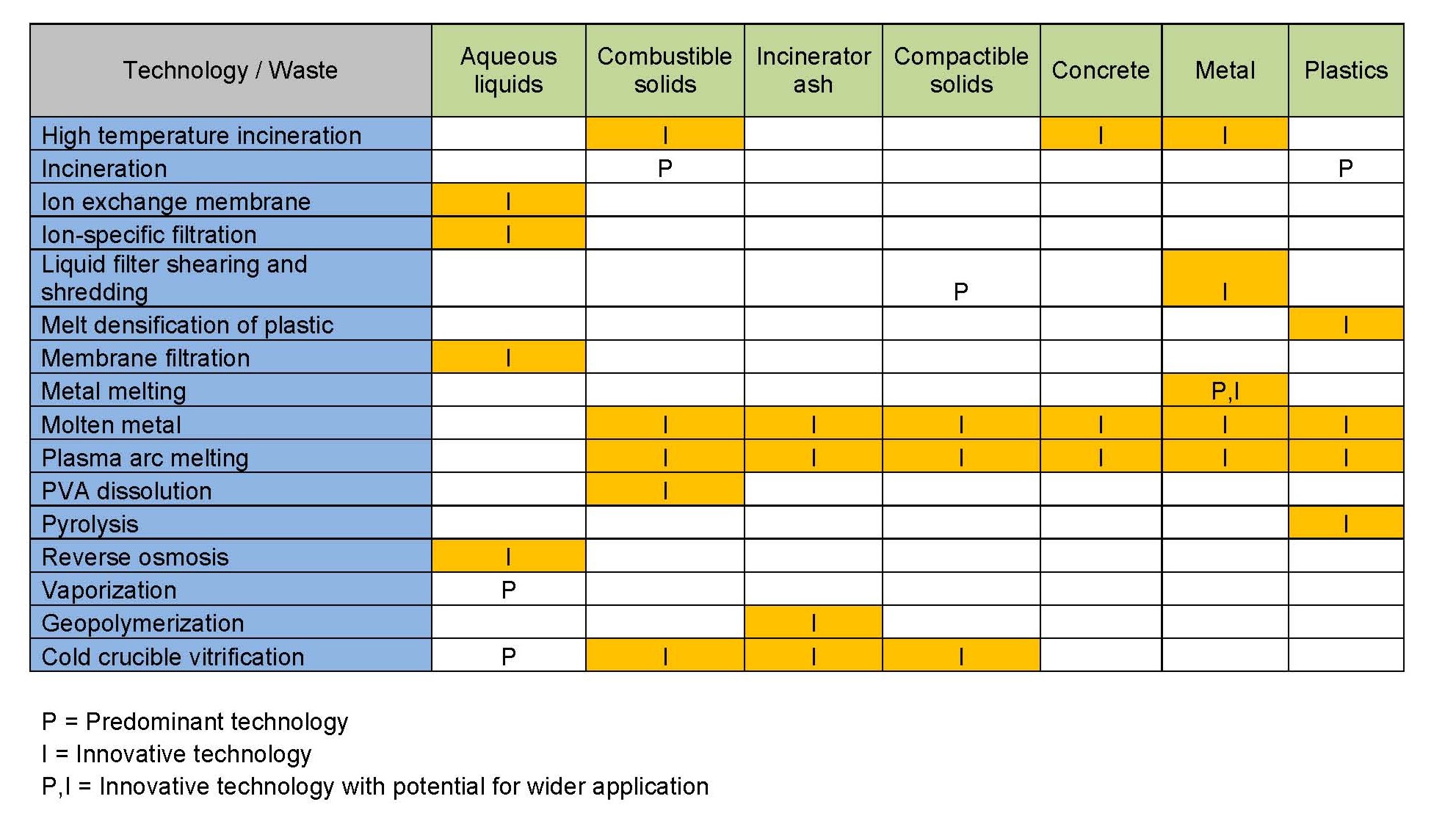 |
||
|
Business process of treatment and conditioning low active radioactive waste In the last section of the study, we present a generic workflow for use in treatment and conditioning low active radioactive waste business processs. Selecting technologies used in the treatment-conditioning of radioactive waste, will be determined, for each region, by the available utilities, infrastructure, local circumstances and the national strategy of waste treatment and generation rates. Thus, we consider the following important factors: Availability of decontamination centers and acceptance criteria
Also, in this section of the study, we designed following generic workflow, used in treatment and conditioning of low active radioactive waste. Business process of treating and conditioning low-active radioactive waste. |
||
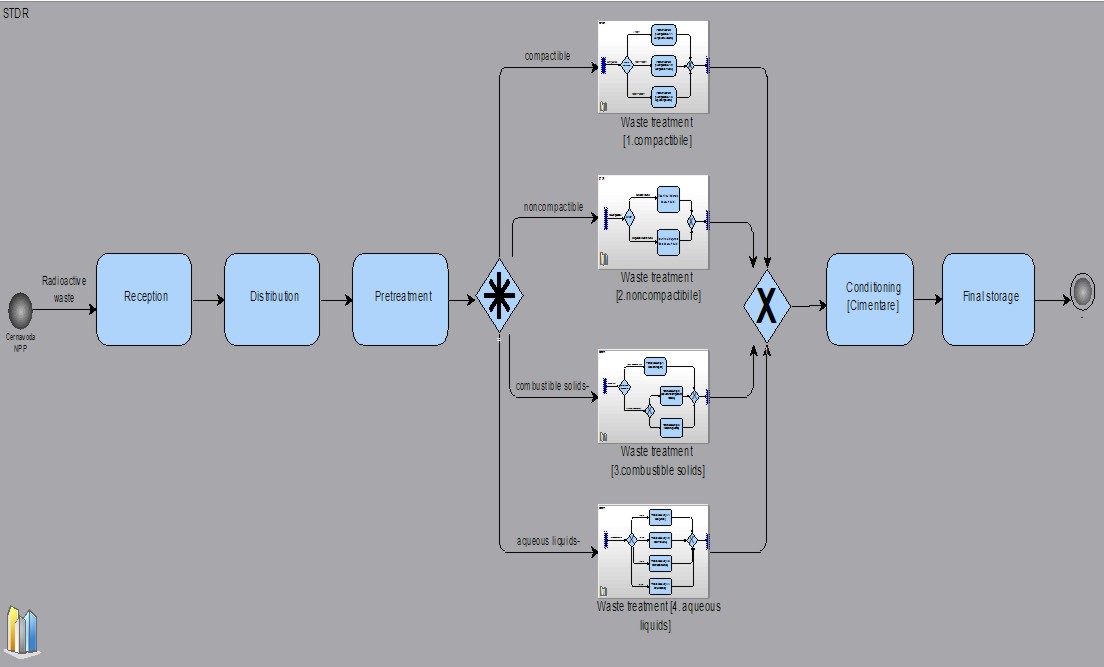 |
||
|
As a conclusion of the study, we can summarize these aspects:
|